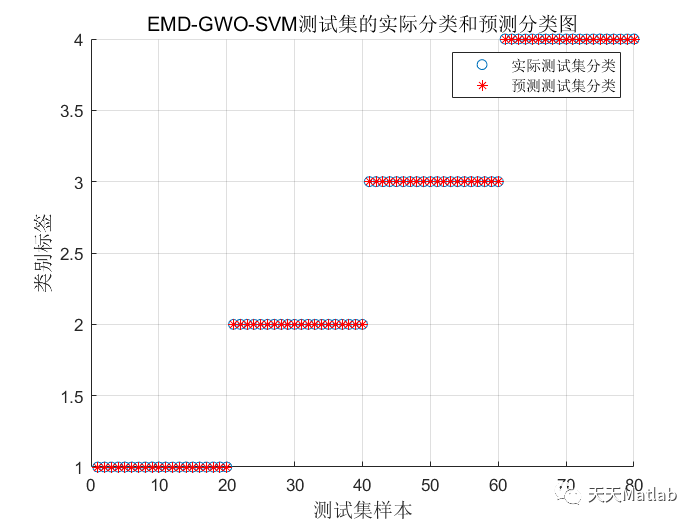✅作者简介:热爱科研的Matlab仿真开发者,修心和技术同步精进,matlab项目合作可私信。
🍎个人主页:Matlab科研工作室
🍊个人信条:格物致知。
更多Matlab仿真内容点击👇
⛄ 内容介绍
电力运行离不开变压器,一旦变压器发生故障将造成难以估量的损失,而传统的变压器故障诊断方法在准确率存在方面不足,因此文章提出一种基于灰狼算法优化支持向量机(GWO-SVM)模型.该方法通过支持向量机(SVM)对故障数据进行分类,并用灰狼算法(GWO)对SVM的核参数g以及惩罚因子C进行优化,通过不断训练GWO-SVM使其故障诊断精度提高.文章分别对比了标准SVM和粒子群优化后的SVM(PSO-SVM)模型,经比较GWO-SVM模型精度比标准SVM模型高7.5%,比PSO-SVM模型高2.5%,证明GWO-SVM模型具有可行性.
EMD分解是一种用于信号处理和图像处理领域的技术,它可以将信号或图像分解成多个局部特征,并对这些特征进行处理和分析。灰狼算法则是一种基于自然界中灰狼族群行为特点的优化算法,可用于解决非线性、高维度的复杂问题。支持向量机(SVM)则是常用的分类器之一,其用于模式识别和数据挖掘等任务。
将EMD分解与灰狼算法结合,可以解决支持向量机中参数优化问题,并利用EMD分解提取的局部特征来改善模型的预测精度。具体流程如下:
-
EMD分解:对原始数据进行EMD分解,将其分解为多个不同尺度的局部特征。
-
初始化灰狼个体:根据EMD分解得到的局部特征,初始化灰狼个体群。
-
计算适应度函数:利用SVM算法和EMD分解得到的局部特征进行训练和测试,并计算出每个灰狼个体的适应度。
-
灰狼个体调整:根据当前适应度值,使用灰狼算法对每个灰狼个体进行位置调整和参数更新。
-
设定终止条件:设定迭代次数或适应度值达到一定精度时停止算法。
-
输出最优解:输出最终得到的最优灰狼个体和其对应的SVM模型参数,用于后续的预测和分类任务中。
⛄ 部分代码
clear all
close all
clc
%% Parameters
fd=100; % frequency doppler
ts=1e-3;
t=[0:ts:0.1-ts];
N=length(t); % 2M+1 complex Gaussian random variables
M=floor((N-1)/2);
f0=fd/M;
ind=f0; % frequency index
fmax=1e3; % maximum simulation frequency
fmin=-fmax; % minimum simulation frequency
fr=[fmin:ind:fmax]; % frequency range for simulation
zeta=0.175; % Underdamp value for zeta
w0=2*pi*fd/1.2; % Natural angular frequency
%% Third order filter
% Coefficients
a=w0^3;
b=(2*zeta*w0)+w0;
c=(2*zeta*(w0^2))+(w0^2);
%% building third order Filter in s-domain z-domain w-domain and f-domain
syms f s w; % define symbols
tf_s=tf(a,[1 b c a]); % 3rd order tf in S domain
tf_z=c2d(tf_s,ts,'tustin'); % tustin: bilinear transformation
h_s=(a/((s^3)+(b*(s^2))+(c*s)+a)); % 3rd order filter in S Dommain
h_W=subs(h_s,s,1i*w); % 3rd order filter in w Dommain
h_f=subs(h_W,w,(2*pi*f)); % 3rd order filter in f Dommain
%% AutoCorrelation
hv=subs(h_f,f,fr); % filter gain for each frequency
hv_double=double(hv); % convert gains into double
Autocorr=xcorr(hv_double); % Autocorrelation
Autocorr=real(Autocorr*(1/max(Autocorr))); % normalize AutoCorr
%% choose the values from AutoCorrelation to plot
L=ceil(length(Autocorr)/4);
AutocorrPlot=Autocorr(L:end-L+1); % remove the first and fourth quarters
plot(fr/fd,AutocorrPlot) % Plot AutoCorrelation with rexpect to f/fd
title('Third Order Filter (fd=100Hz, w0=2*pi*fd/1.2 , zeta=0.175)')
xlabel('f/fd')
ylabel('AutoCorrelation')
xlim([-5 5])
grid on
[pks,locs] = findpeaks(AutocorrPlot); % find peak values and their locations
hold on
scatter(fr(locs)./fd,AutocorrPlot(locs),'filled','blue')
stem(fr(locs)./fd,AutocorrPlot(locs),':r','linewidth',2)
%% plot autcorrelation at positive side
L2=ceil(length(AutocorrPlot)/2);
AutocorrPlot_P=AutocorrPlot(L2:end); % Positive side of autocorr.
fr_P=fr(L2:end); % Positive frequencies
figure
plot(fr_P/fd,AutocorrPlot_P)
title('Third Order Filter (fd=100Hz, w0=2*pi*fd/1.2 , zeta=0.175)')
xlabel('f/fd (positive frequencies)')
ylabel('AutoCorrelation at Positive frequencies')
xlim([0 5])
grid on
%% using autocorrelatio function
figure
autocorr(hv_double,length(hv_double)-1);
% PSD
a=abs((hv_double).^2);
figure
plot(fr/fd,a)
xlim([-2 2])
title('Third Order Filter (fd=100Hz, w0=2*pi*fd/1.2 , zeta=0.175)')
xlabel('fr/fd')
grid on
ylabel('PSD')
[pks,locs] = findpeaks(a);
% max_pks_L=locs(find(max(pks)));
hold on
scatter(fr(locs)/fd,a(locs),'filled','r')
stem(fr(locs)/fd,a(locs),'filled','.-.r','linewidth',1.5)
plot([-2 2],[max(a) max(a)],'.-.green','linewidth',1.5)
%% Impulse response of Digital Filter (channel)
[numZ denZ ts]=tfdata(tf_z,'v');
figure
[h,n] = impz(numZ,denZ);
%% find n0 : at this point h(n) become negligible
[pks,locs] = findpeaks(h);
nv=0.01; % negligible value as a percentage of maximum value
b=find(pks>=(nv*max(pks)));
peak_no=min(pks(b));
n0=max(locs(b));
%% plot impulse response
subplot(2,1,1)
plot(n.*ts,h)
xlabel('time [sec]')
title('Impulse response of channel "3rd order filter" using plot')
grid
hold on
scatter(n0.*ts,peak_no,'filled','r')
subplot(2,1,2)
stem(n,h)
xlabel('n [samples]')
title('Impulse response of channel "3rd order filter using stem"')
grid
hold on
scatter(n0,peak_no,'filled','r')
%% normalizing the filter H(Z)
numZ_N=numZ./sqrt(sum(h.^2)); % normalize numerator of H(z)
tf_Z_N=tf(numZ_N,denZ,ts);
%% Generating an input signal with unit power => (power_db = 0)
% Ip is vector (n0 ,1) , simulation time:T=0.1 sec
IP_no=(1/(sqrt(2))).*(randn(1,n0)+(1j*randn(1,n0)));
IP_T=(1/(sqrt(2))).*(randn(1,length(t))+(1j*randn(1,length(t))));
IP=[IP_no IP_T]; % first n0 bits for transient response
% Output from filter
Y=filter(numZ_N,denZ,IP); % output from filter
Y_T=Y(n0+1:end); % output after removing transients
% Output in DB
Y_T_db=20.*log10(abs(Y_T)); % output when length of input=T in dB
% root mean square value of input signals
rms_Y_T=rms(abs(Y_T)); % rms of output length = T
rms_Y_T_db=20.*log10(abs(rms_Y_T)); % rms of output length = T in dB
ten_dB_below=rms_Y_T_db-10;
%% plotting output from filters
figure
plot(t,Y_T_db)
hold on
plot([t(1) t(end)],[rms_Y_T_db rms_Y_T_db],'.-.black','linewidth',1)
plot([t(1) t(end)],[ten_dB_below ten_dB_below],'.-.r','linewidth',1.5)
grid
legend('AMPLITUDE','RMS LEVEL','10 dB below RMS LEVEL')
xlabel('Time[sec]');
ylabel('Magnitude [dB]');
%% exact crossing and exact average fade duration in this run
[CN_PD_s CPV AFD_s FT]= Cross_N_PD(Y_T_db,ten_dB_below,ts);
disp('Simulation Result: Number of Crossing per 0.1 sec "PD: Positive Direction"')
CN_PD_s % simulation crossing number during 0.1 sec
disp({'Fraction of time when signal goes below specific level';'total duration of fade per second'})
FT
disp('Simulation Result: Average Fade Duration')
AFD_s=(round(AFD_s.*1e5))/(1e5);
title({'single realization of the Amplitude';strcat(' inthis run AFD=',num2str(AFD_s),' LCN/0.1sec=',num2str(CN_PD_s))})
%% plot filled circles at crossing points in the positive direction
hold on
loc=find(CPV);
scatter(t(loc),ten_dB_below.*ones(1,length(loc)),'filled','blue')
%% Expectation of Level Crossing Rate in Ts time and Average Fade Duration
RowdB=ten_dB_below-rms_Y_T_db;
Row=10.^(RowdB/20);
disp('Theoretical LCR "Level Crossing Rate" ')
LCR=(sqrt(2*pi).*fd.*Row.*exp(-(Row.^2))) % Expected level Crossing rate per second
disp('Theoretical AFD "Average Fade Duration" ')
AFD=(exp(Row.^2)-1)/((sqrt(2*pi)).*fd.*Row)
%% check rayleigh fading of Amplitude
figure
ksdensity(abs(Y_T))
title({'Distribution of Amplitude'; 'should be approximately like Rayleigh fading distribution'})
grid
%
figure
[x,tt]=ksdensity((angle(Y_T)));
l2=find(tt>pi);
plot(tt,x)
title('PDF of Angles');
grid on
xlabel('Angel "Radian"');
hold on
plot([tt(1) tt(end)],[1/(2*pi) 1/(2*pi)],'.-.r','linewidth',2)
legend('Distribution','1/(2*pi) level')
xlim([tt(1) tt(end)])
⛄ 运行结果







⛄ 参考文献
[1] 黄海松,范青松,魏建安,等.基于CEEMDAN-IGWO-SVM的轴承故障诊断研究[J].组合机床与自动化加工技术, 2020(3):5.DOI:CNKI:SUN:ZHJC.0.2020-03-006.
[2] 熊军华,师刘俊,康义.基于灰狼算法优化支持向量机的变压器故障诊断[J].信息技术与信息化, 2020(11):4.DOI:10.3969/j.issn.1672-9528.2020.11.044.
[3] 周莉鲍志伟.基于灰狼算法优化SVM的变压器故障诊断[J].长江信息通信, 2022, 35(9):27-29.
⛳️ 代码获取关注我
❤️部分理论引用网络文献,若有侵权联系博主删除
❤️ 关注我领取海量matlab电子书和数学建模资料























 1052
1052











 被折叠的 条评论
为什么被折叠?
被折叠的 条评论
为什么被折叠?










